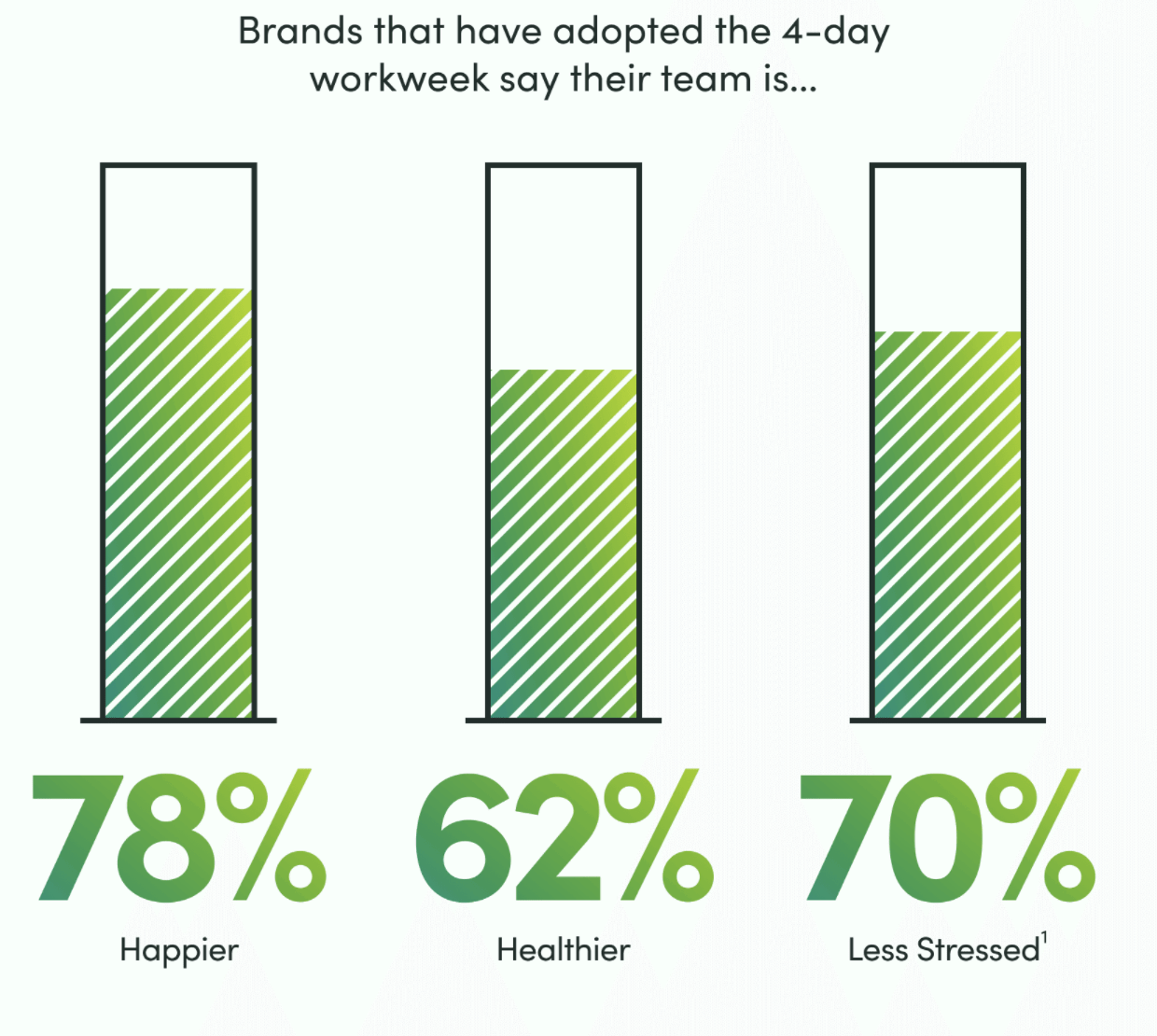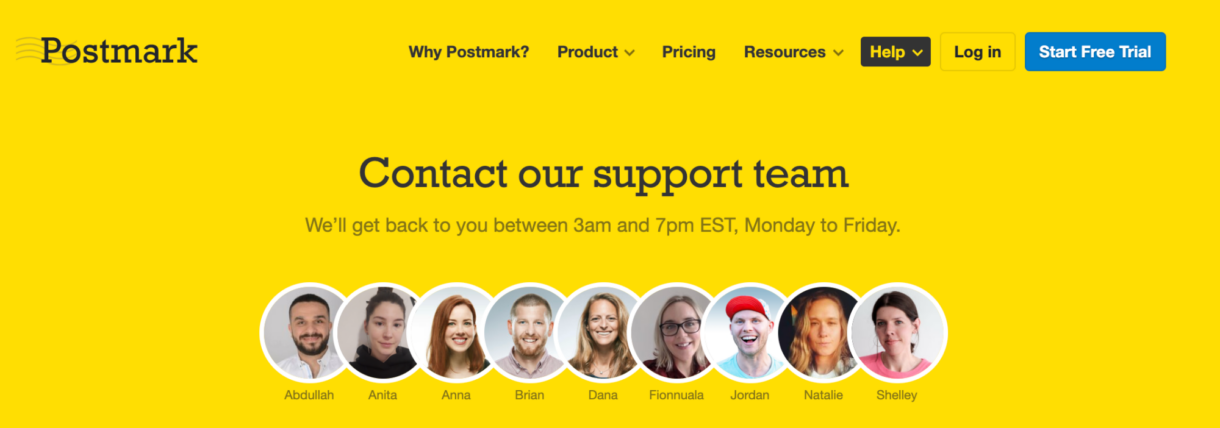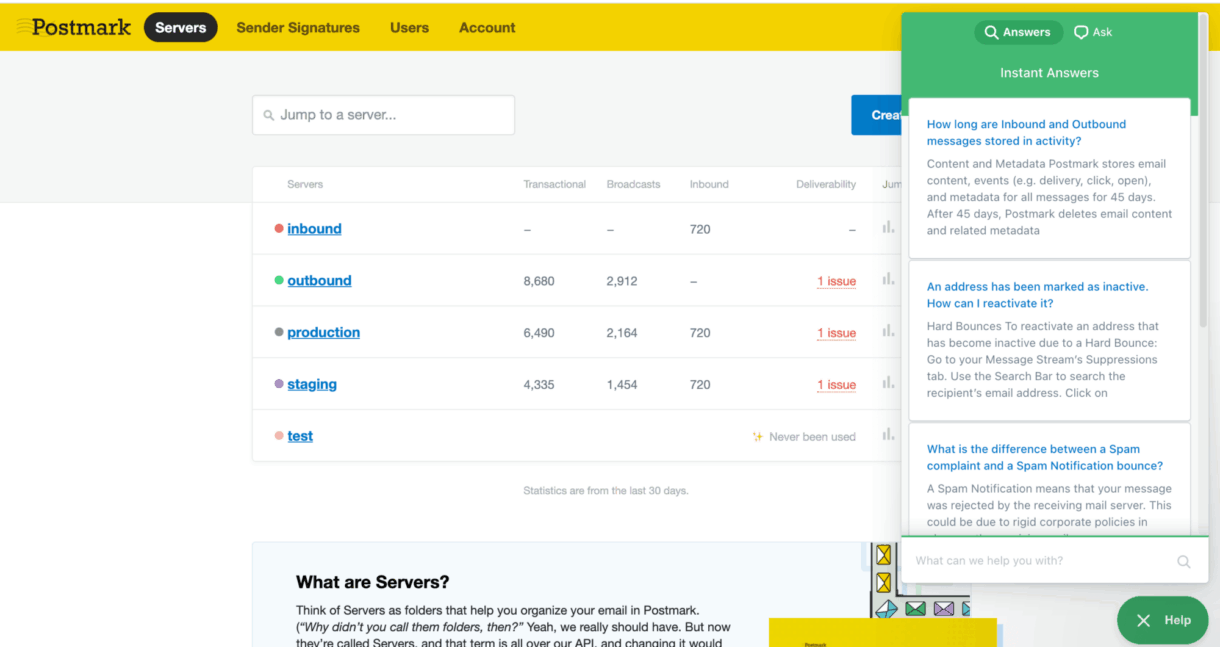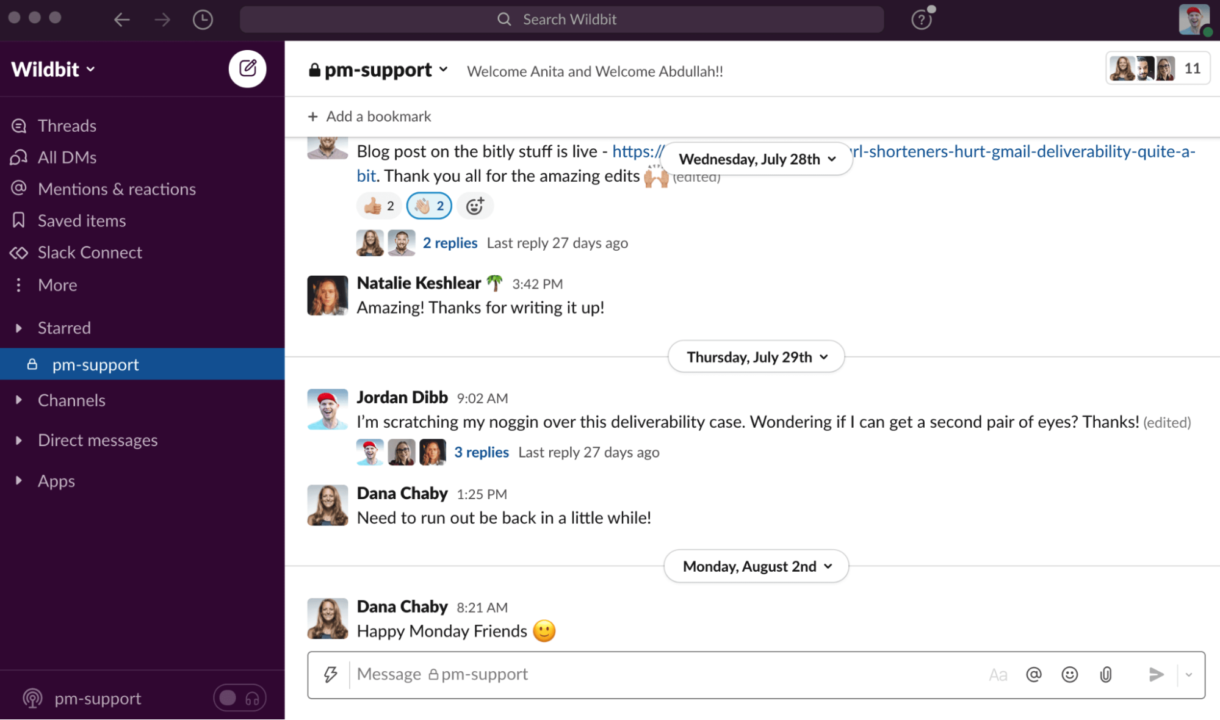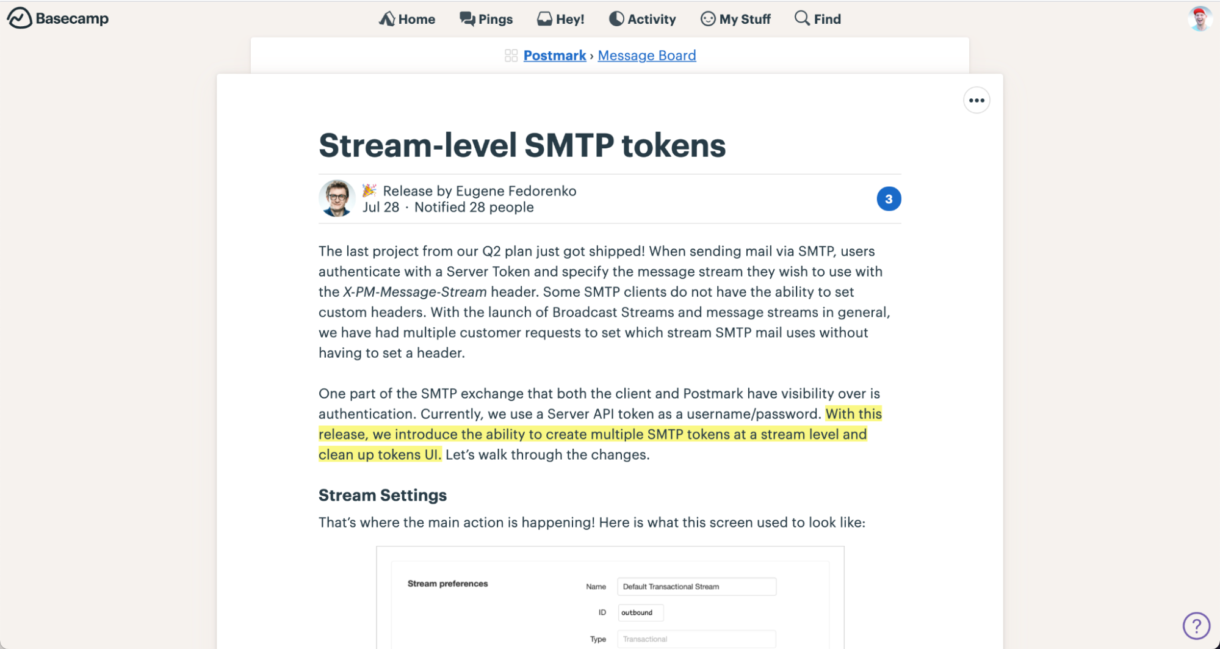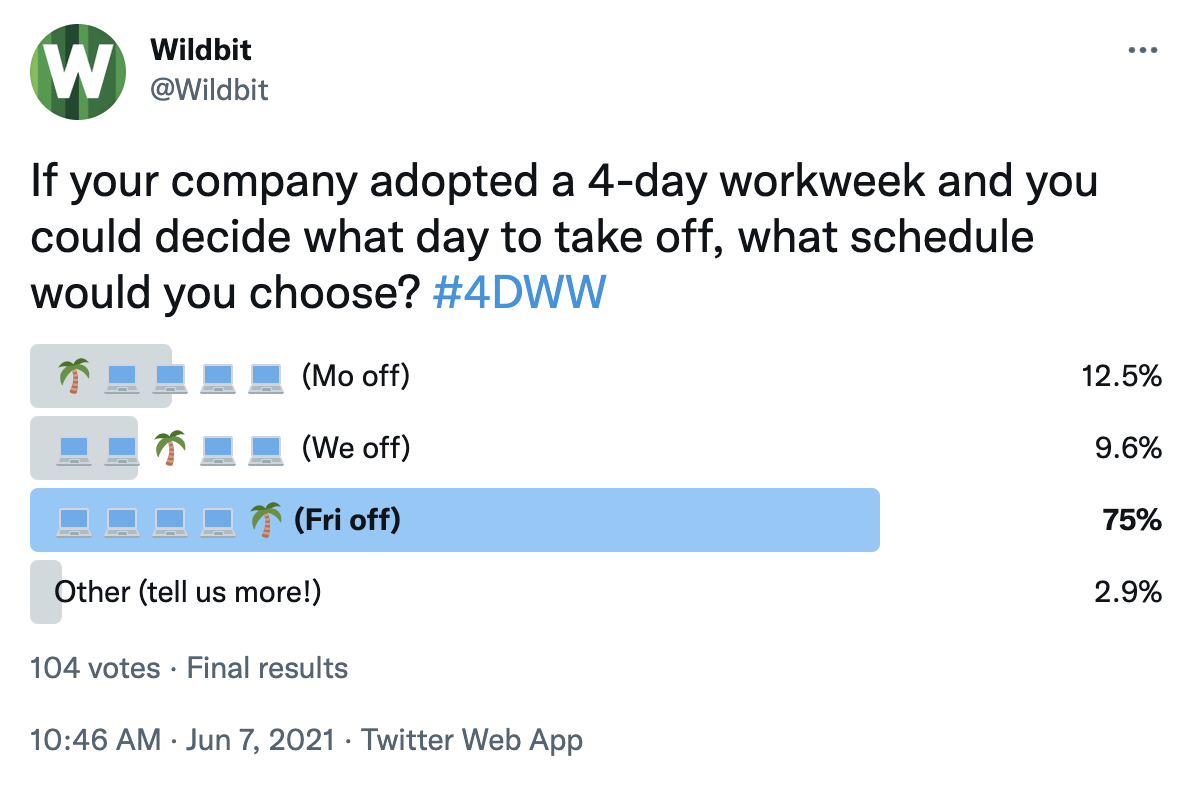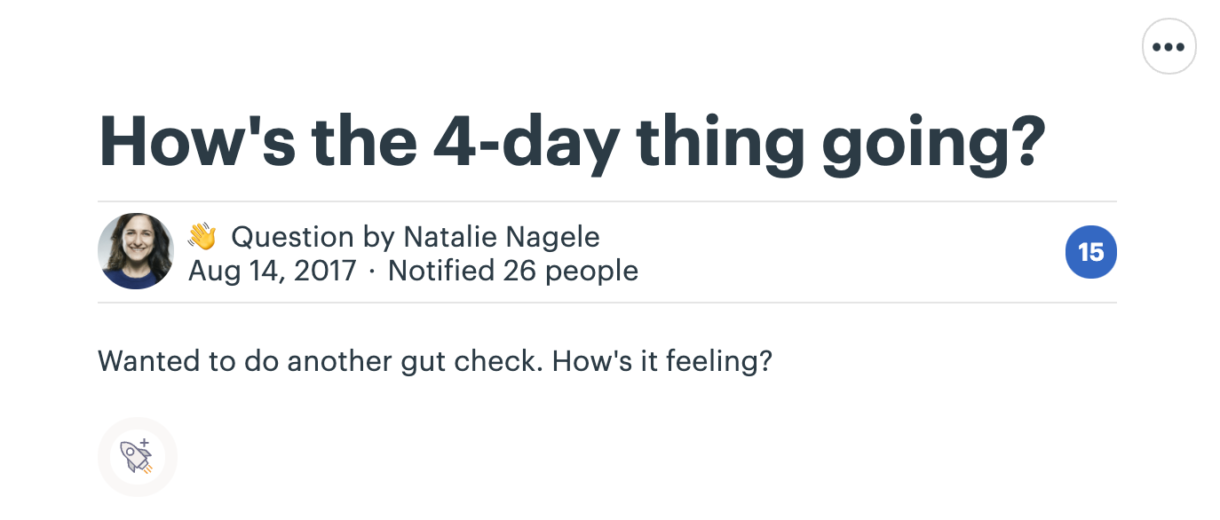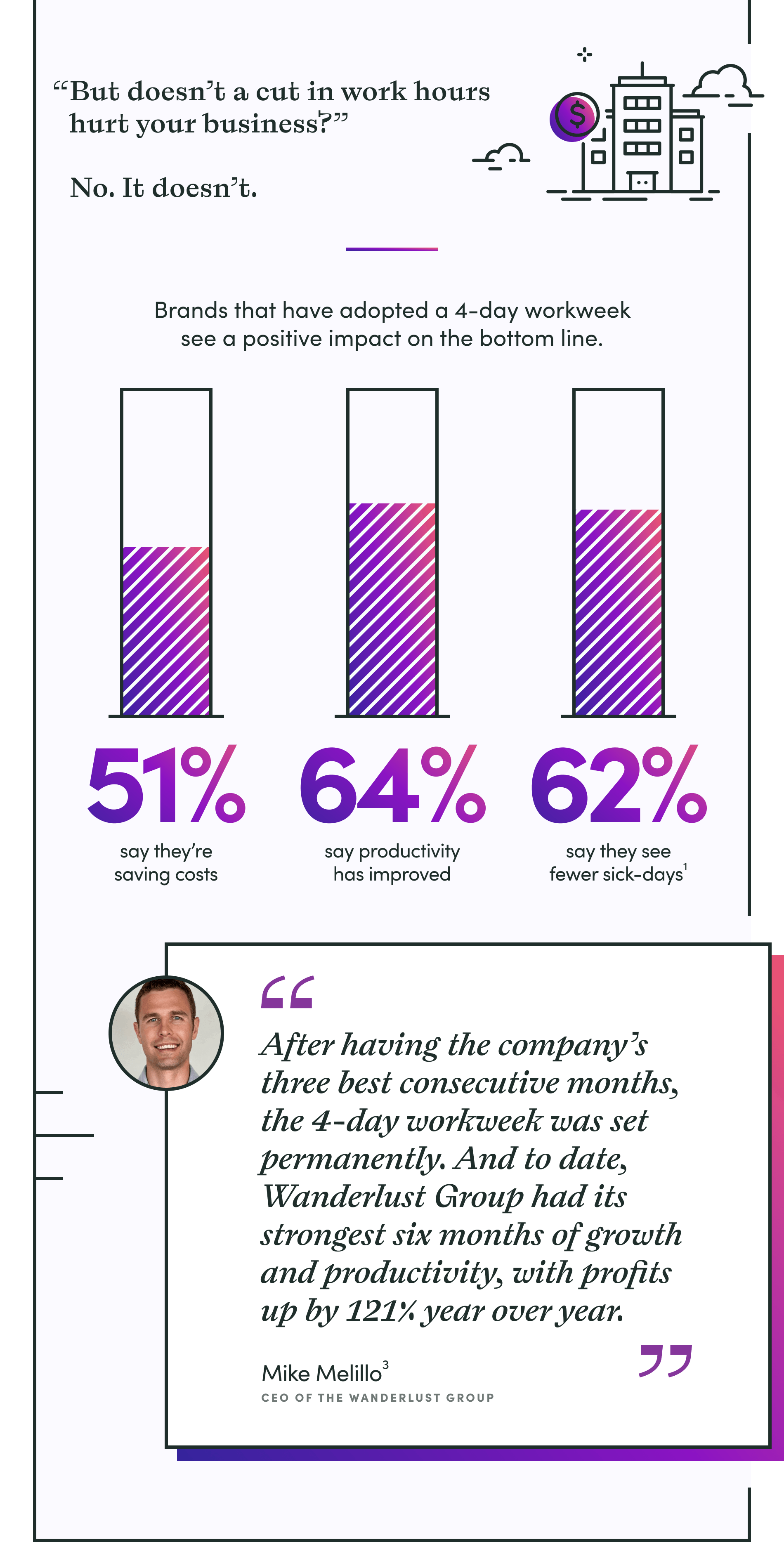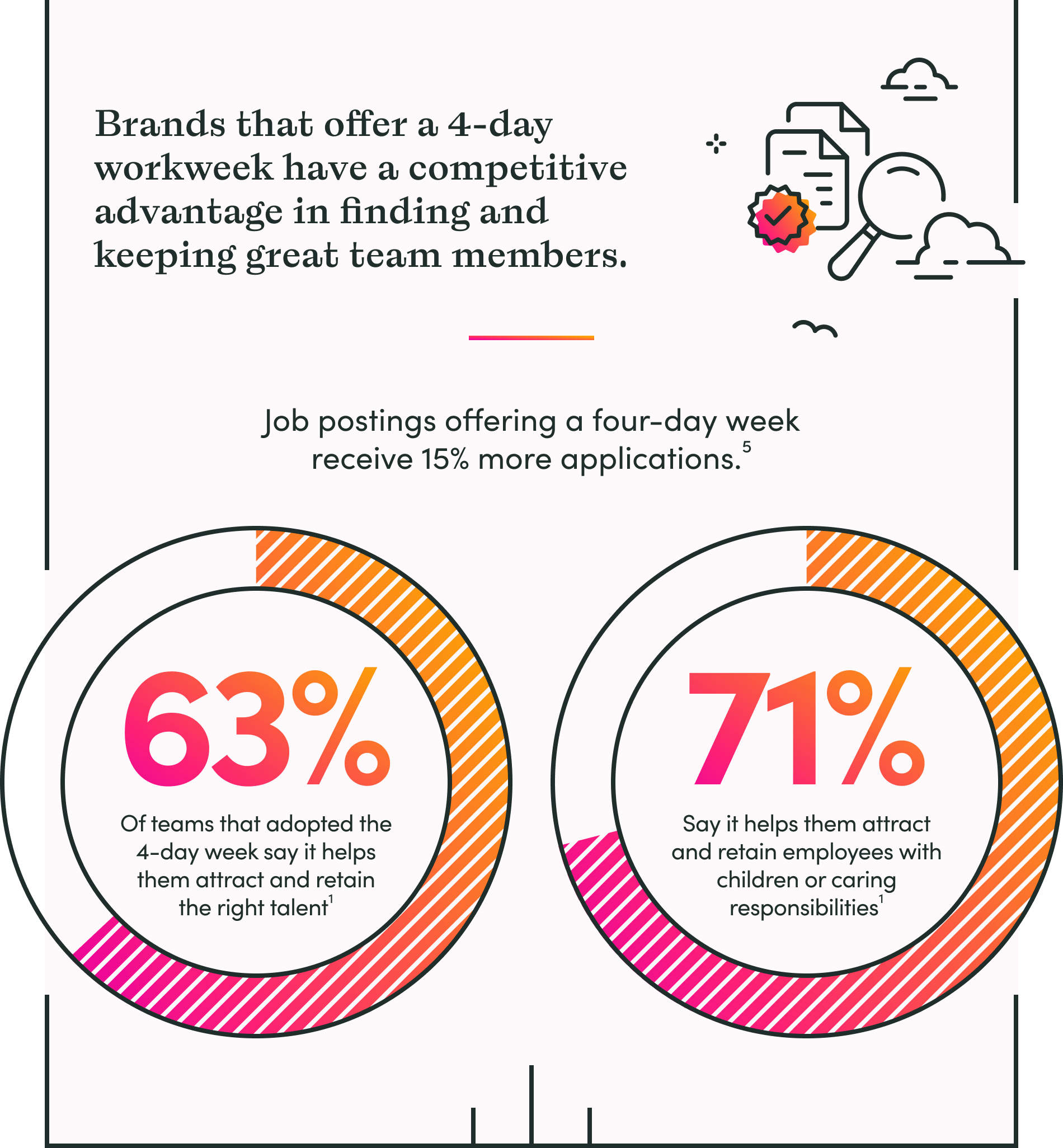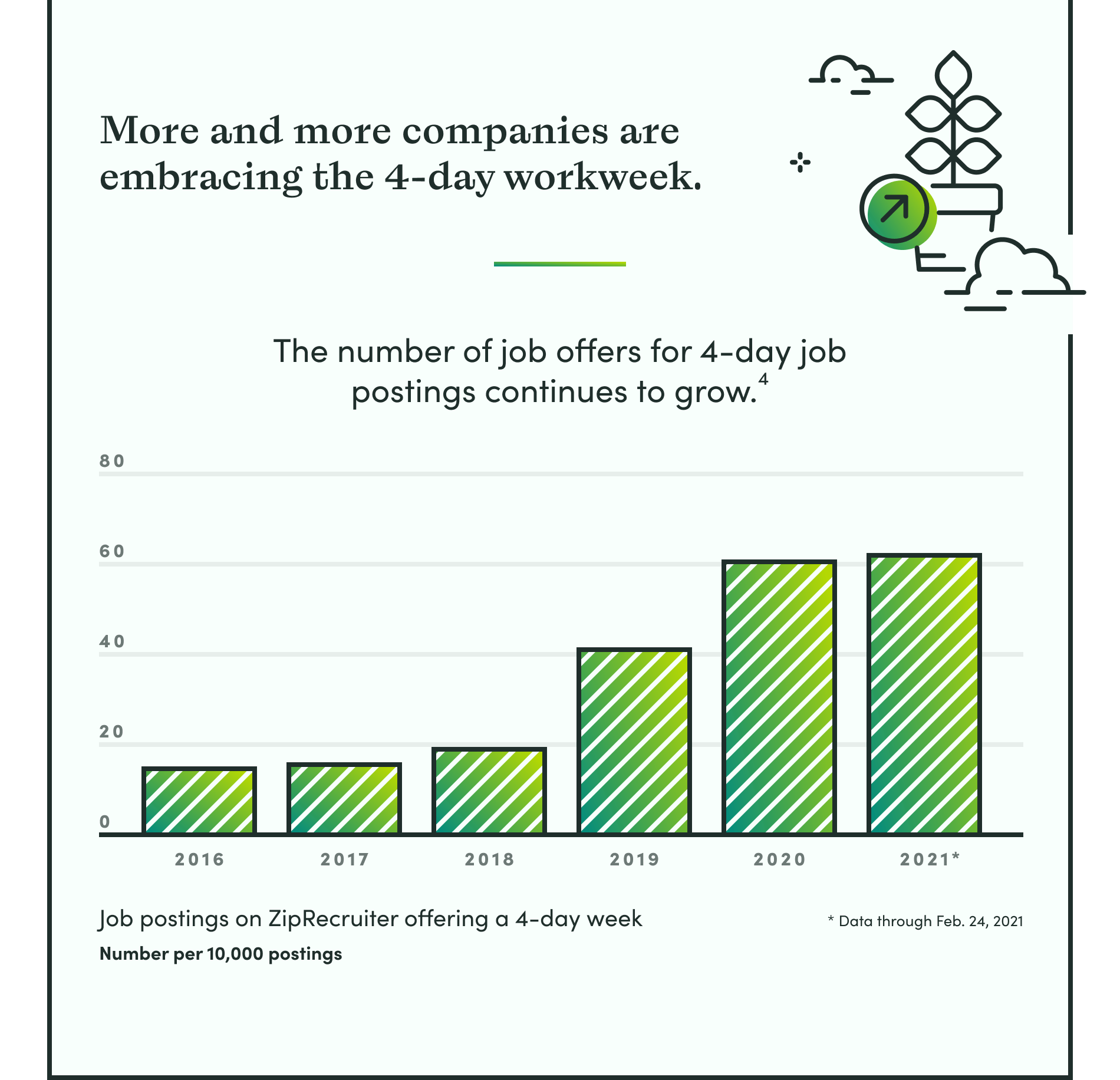Here at Wildbit, we adopted a 4-day workweek in 2017, long before the pandemic. What started as a summer experiment ended up being so successful that we never stopped. In fact, we are passionate advocates for a shorter workweek as a people-first way of doing business.
We want to encourage more businesses to consider this way of working, so in September 2021, we brought together leaders from four companies for a conversation about how to implement a 4-day workweek. They shared why and how they switched to a 4-day week, how it’s been going, and what they’ve learned in the process. Below is the full video, plus the key insights that emerged from our discussion.
Panelist and company profiles

From left to right: Meghan, Nicole, Natalie, and Dawn
Meghan Keaney Anderson is CMO at The Wanderlust Group, an outdoor tech company connecting adventurers to destinations. They’re a remote-first company with 50 team members, and have been on a 4-day week since July 2020.
Nicole Miller is Senior People Ops Manager at Buffer, a social media management software company with 90 team members around the world. They’ve been working 4 days a week since May 2020.
Natalie Nagele is CEO at Wildbit, a people-first, product-agnostic software company with 36 team members across 10 countries, and working 4 days a week since 2017.
Dawn Quigg is Client Services Director at Awin, a global affiliate marketing network with 1000+ team members across the globe. They adopted a 4-day week in January 2021.
Motivations for the 4-day workweek experiment
For Wanderlust, Buffer, and Awin, the initial impetus for the four-day workweek experiment was the exhaustion and burnout caused by the pandemic. They wanted to alleviate stress and promote well-being, especially for parents and caregivers who were stretched thin trying to juggle work and family.
As a company that’s all about spending time outdoors, The Wanderlust Group thought the extra day off would give people more opportunities to spend time not just with family and friends, but also outside, close to nature. Buffer, a remote-first company with a keen interest in the future of work, wanted to give people “extra time for life” and to support employees who wished for “flexibility in time.” In Awin’s case, the pandemic made them think about how best to “offer something back to employees and improve their wellbeing.”
At Wildbit, however, the shift to the 4-day workweek happened in 2017. Our founders, Natalie and Chris Nagele, were deeply influenced by Cal Newport’s 2016 book, Deep Work: Rules for Focused Success in a Distracted World. Newport argues that our brains can only do focused, meaningful, productive work for about 4 hours per day; the rest of our time is taken up by unnecessary distractions and busywork.
We spend a lot of our days on shallow work. Things like meetings, emails, closing tickets and talking to each other. What if we all just buckled down and got some really thoughtful, meaningful work done, could we work less?
—Natalie Nagele, Wildbit (May 2017 blog post)
Natalie and Chris decided to try a 4-day workweek experiment to see if it’s possible to work more intentionally and efficiently by removing distractions. However, the flip side of doing deep, focused work is giving the brain enough time to rest and recharge—hence the 3-day weekend. The 4-day week requires both deep work and deep rest.
The results
1. Productivity either stayed the same or improved
When Buffer began its initial one-month trial of the 4-day workweek in May 2020, they fully expected a drop in productivity due to the decreased working hours in addition to the mental burden of the pandemic. The actual results surprised them:
We’d already seen the psychological toll of the pandemic and did not expect productivity to stay the same. We expected a huge dip—but that didn’t end up happening. In fact, the numbers really leveled off and stayed that way and felt pretty sustainable.—Nicole Miller, Buffer
Those initial results led Buffer to conduct a six-month trial until the end of 2020. They found that the productivity numbers remained consistent, e.g., the amount of code written was about the same as a similar month in 2019. Seeing no change and no drop in productivity made them realize that the fifth workday was “a bit superfluous, since people were getting around the same amount done in four days.” At the end of the 6-month trial, Buffer reevaluated and made the 4-day week permanent.
Maintaining the same output with one less workday is impressive enough, and this was Awin’s experience, too—but The Wanderlust Group even saw their numbers increase. During their initial trial, they had “the most productive six months ever,” so they made the shorter workweek company policy. After a year of working 4 days a week, their annual recurring revenue (ARR) had grown almost 100% year over year and their NPS stayed above 75.

The Wanderlust Group’s numbers after a year of working 4 days a week
The big takeaway is not that the four-day workweek somehow magically juiced our numbers. It’s that we were able to hit and exceed our numbers while having a four-day workweek.—Meghan Keaney Anderson, The Wanderlust Group
Wildbit’s experience has been similar: a clear trajectory of growth despite working fewer hours, even through the pandemic.
We’ve seen the business grow more in the last three years than it has in its entire history. Not because we do a four-day workweek, but in spite of the four-day workweek.—Natalie Nagele, Wildbit
2. Happier and more engaged employees
It should come as no surprise that the shorter workweek had a positive impact on employees: lower stress levels, improved work-life balance, greater job satisfaction, increased engagement, and more opportunities for personal and professional development.
A really direct, tangible benefit of the four-day workweek was our churn being almost zero from an employee standpoint. Morale went up. People were able to spend real time pursuing passion projects and then bring that energy and enthusiasm back to their work.—Meghan Keaney Anderson, The Wanderlust Group

Amy Cohan from The Wanderlust Group kayaks on one of her Mondays off.
For instance, one Wanderlust employee used her extra day off to teach sailing to youth—and that passion and energy flowed back into her core job working with boaters and marinas. As an outdoor tech company that encourages people to spend time outdoors, this is exactly what The Wanderlust Group had hoped for when implementing the 4-day week.
Similarly, Dawn Quigg at Awin noticed “an improvement in our staff engagement,” which was measured continuously using an internal platform for staff feedback. Many employees were able to spend the fifth day with family, which they appreciated during the isolation of the pandemic, while others added to their skillsets, pursued further learning, or took up new hobbies.
At Buffer, they tracked metrics related to general work happiness, stress levels, and individual autonomy, and compared them at different benchmarks. The overall trend was positive—people were happy at work, felt less stressed, and experienced greater autonomy and flexibility.
Productivity stayed consistent while the self-reported sentiments of team happiness increased, and feeling that they have more balance with their family. It was a huge relief for parents in particular, especially those who were homeschooling or managing a lack of childcare or whatever situation with their kids. That’s been a really great thing.—Nicole Miller, Buffer
3. More efficient processes and workflows
Making the shorter workweek successful means finding smarter and more efficient ways to work. At Wildbit, this meant reducing meetings and other noise to a minimum, so people could give their full attention to their most important work.
We didn’t just implement a four-day workweek. We then also had to implement different ways of working: removing meetings, removing distractions, really focusing on deep work. We had to be really intentional about how we work. It’s been a really exciting journey and it continues.—Natalie Nagele, Wildbit
Similarly, the folks at Awin started to examine their existing ways of doing things, and began to innovate and experiment in order to improve and streamline their processes and workflows.
We’ve seen staff really challenge the way they work. For instance, looking at how the historic process has worked and challenging it, saying ‘Well, we can do that a little bit better’ or ‘There’s a smarter way of doing this particular process.’ It’s been great to see staff really challenge things and find smarter and more efficient ways to do things. That’s been fantastic, and it obviously helped staff get five days’ worth of work into four, if they find ways to be more efficient at the same time.—Dawn Quigg, Awin
4. Attracting and retaining top talent
If the four-day workweek makes people happier and less stressed, it should be no surprise that it’s great for attracting and retaining top talent. Candidates have choices, so the flexibility and work-life balance offered by the shorter workweek and three-day weekend is a real selling point.
For a small company like The Wanderlust Group, working four days has enabled them to stand out, get more applications overall, and recruit excellent candidates who might have otherwise gone elsewhere.
It’s been phenomenal for recruiting. The tech space is very crowded and we face a lot of competition for top talent in the region we’re in. We’re a smaller company, so we don’t have the credence and reputation that larger companies have. The 4-day workweek can be a breakthrough in a conversation with a top-notch recruit. We really believe this has played a factor in closing a lot of people in roles that we really wanted.—Meghan Keaney Anderson, The Wanderlust Group
Once those recruits have come on board, Awin’s experience shows that they’re also more likely to stay with the company thanks to this unique benefit.
Not only can you attract top talent, but you can retain them longer. We’ve definitely seen that churn has dropped amongst our staff and that’s fantastic. I think it’s two-fold: you’ve got a real USP for attracting new talent into the business, and you’ve got a benefit that many, many staff really value and appreciate.—Dawn Quigg, Awin
Advice for implementing the 4-day workweek
The benefits of the 4-day workweek certainly make it worth considering—but it’s a major change, and various details need to be worked out to make it successful. During our live conversation, we got a lot of audience questions through Slido and through the Zoom chat, and asked our panelists to respond and share their advice based on what they’ve learned so far.
Be intentional about which day to take off
A popular question that came up was which day of the week do you take off, and how did you choose? A related question is: should it be the same day for everyone? Customer support teams often provide week-long coverage, so how does it work for them?
The Wanderlust Group ended up taking Mondays off because Fridays are typically a busy day for the marinas and campgrounds they work with, so they wanted to be available for them on Fridays. They also found that having Monday off allowed the team to plan and reflect on the week ahead—especially for parents of young children who may have busy weekends—and start their week strong on Tuesday.
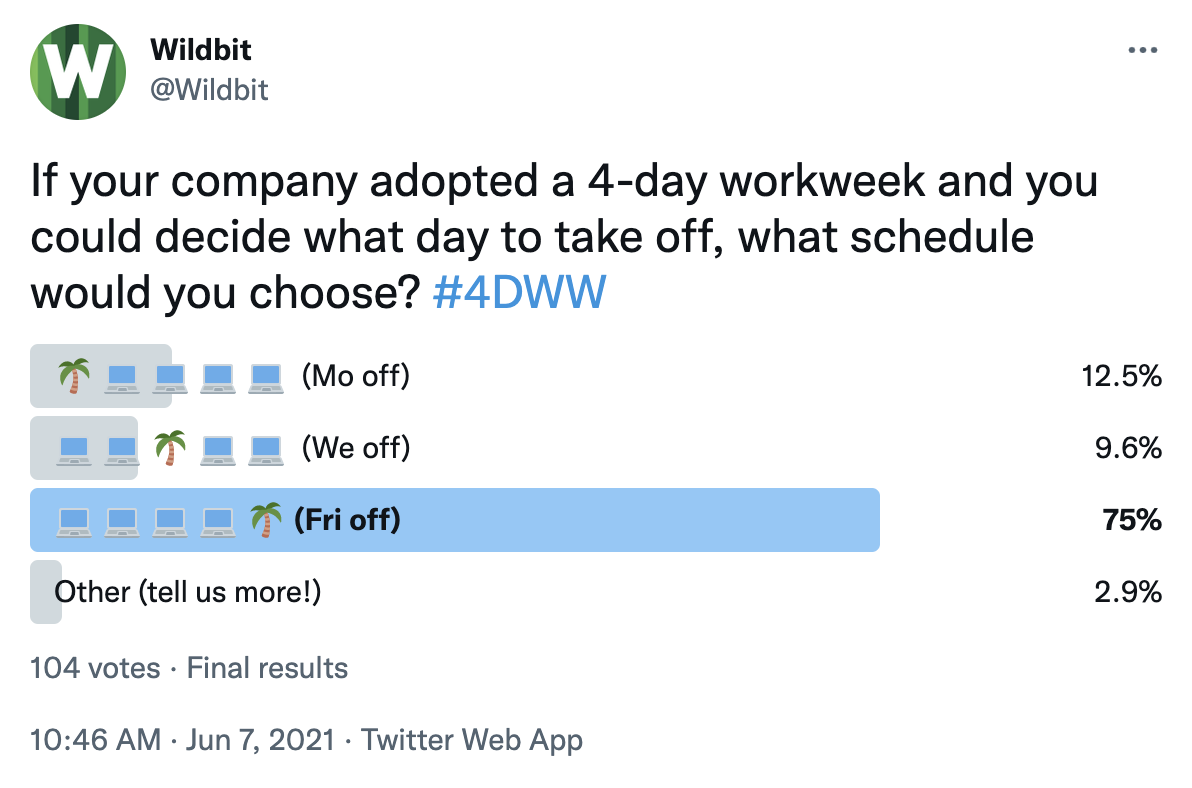
From our Twitter poll, it seems Friday is the clear favorite!
Buffer and Wildbit experimented with allowing people to choose their day off, but it became hard for teams to keep track of who was available when. So they eventually settled on Friday as the common day off, which allows for consistency and ease of collaboration, especially with team members spread across multiple time zones around the world.
Awin decided to give people the flexibility to choose which day they wanted to take off—as long as it’s clearly communicated to their manager. Each department or team works out a rotation system internally so that there’s always coverage for their client-facing work to continue uninterrupted. This rotation system has worked out well for them, but it does require planning and coordination (as a reminder: the company does employ 1000+ people!).
Customer support teams are a special case since they often need to provide coverage 5 days a week, or even 24/7. At Buffer, this is handled by rotating the days off to ensure week-long coverage while still working four days. Similarly, the folks on Wildbit’s customer support team work either Mon-Thu or Tue-Fri so that we have 5 days of coverage, but everyone still gets 3 consecutive days off.
Allow flexibility, but within limits
Another question we got was: what if somebody wants to work five days a week? It’s really a question about flexibility and being able to choose, since some people might prefer working 5 shorter days rather than 4 full days. Or there might be folks who do their best work in the evening. Or someone might feel inspired and want to get going on a project during the weekend.
Awin’s Dawn Quigg says it’s important to give people choice and flexibility rather than dictating how and when they should work. Similarly, Wanderlust’s CEO told the team they can choose their hours as long as they’re not emailing people or booking meetings at odd hours or off days. That way, one person’s choices don’t end up putting pressure on other people to be logged in outside of their working hours.
Here at Wildbit, Natalie used to feel strongly about people not working on Friday, but she received feedback that they wanted flexible hours. So now we have a 32-hour workweek with flexible hours. Ultimately, it’s not about tracking or policing the number of hours worked, but whether the work gets done.
Keep salaries the same, based on output not hours
One audience question that got upvoted by a lot of attendees had to do with salaries. If people are working fewer days, should they get a pay cut? Also, does working 4 days mean four 10-hour days?

A lot of folks had this question!
The answer from our panelists was a clear and unanimous no. All four companies kept salaries the same because they’re paying for the output or the results, which have either stayed the same or improved. They also did not try to fit 40 hours into 4 days, but maintained an 8-hour day.
As Wanderlust’s Meghan Keaney Anderson puts it, “We still pay the same full-time salary that we paid before because we’re paying for output, not for hours in the chair.” Awin’s Dawn Quigg agrees: “We’ve very much tried to move away from the idea of how many hours you work in a day. Rather, what’s the output of your role and what deliverables are you working towards?” She says focusing on output rather than hours also enables people to get their work done efficiently within the four days.
Natalie, our CEO at Wildbit, says she’s often been asked whether a 4-day week means 40 hours crammed into four days. So she now describes it as a 32-hour week to clarify that it’s four 8-hour days. Salaries at Wildbit remained the same during our transition to the 4-day week in 2017. In addition, we recently rolled out location-agnostic pay, because if compensation is based on output, then where someone lives shouldn’t affect their salary either.
Review vacation and PTO policies, adjust if necessary
Another great audience question had to do with vacation and time-off policies. Technically, a shorter workweek means people are already getting more time off than before—but on the other hand, if they’re producing the same amount of output, then they’re still doing the same work. So what impact (if any) should the four-day week have on vacation and PTO?
The Wanderlust Group and Buffer decided to keep their vacation policies the same, since that fifth day should be properly considered part of the weekend, and not really a day off. Awin, on the other hand, felt that with bank holidays usually falling on a Monday and people typically taking Fridays off, there would often be 3-day weeks. So, after much debate, they decided that if someone wanted a day off during a week that already includes a bank holiday, they should request a vacation day.
At Wildbit, we used to have 25 PTO days, or 5 full weeks. After moving to the 4-day week, we ended up lowering the PTO to 20 days because that still translates to 5 full weeks. In other words, the number of full weeks off stayed consistent, while the number of PTO days changed because a ‘full week’ is now counted differently.
Clearly, there’s no one-size-fits-all answer to the vacation and PTO question, so each company has to decide what will work for them.
Model change from the top
Getting everyone on board with a new idea can be challenging, so it helps to model change from the top. When implementing the 4-day workweek at Buffer, it helped that their CEO was a champion and a pioneer. “It’s really important that he set the example and set the tone for the company as a whole,” says Nicole Miller. It also helped to frame the pilot as an experiment so that people felt invested in making the experiment a success.

The blog post where Buffer’s CEO announced the 4-day workweek
Dawn Quigg of Awin agrees that leadership and management have to buy into this new way of working first, so they can model it for the team: “When the management lives and breathes it, that sets a nice example for the rest of the staff. That’s what our CEO did—it was something he pioneered. It’s important that the vision comes from the top.” There might still be pushback at first since you’re asking people to change longstanding habits and ways of thinking. But it’s important to get everyone on board, since a rotational system (like they have at Awin) won’t work unless everyone is in it together.
Emphasize communication, documentation, and async work
Nicole Miller at Buffer emphasizes the importance of good communication and strong documentation practices in order to work efficiently within a four-day week. Especially for companies that are remote and distributed, you don’t want people to be stuck in their work because they’re missing a key piece of information or input from another person. Hence the vital importance of communicating clearly, documenting everything, and working asynchronously.
At Awin, for instance, they rely heavily on the project management tool Asana. People document their work in it so that someone else can pick up where they left off, and the tool acts as a knowledge bank and a repository of handovers or ways of doing a certain process. Having this central tool enables things to run smoothly even while different people are off on different days.
Similarly, at Wildbit, we enable each other to do deep work by defaulting to async as a remote work best practice. We use communication, project management, and documentation tools like Basecamp, Notion, and Dropbox Paper to collaborate effectively across time zones and avoid disrupting people’s schedules with unnecessary meetings or calls.
Be patient and set realistic expectations
Longstanding habits and workplace norms can’t be changed overnight. Getting used to a different way of working requires a mindset shift, so you have to give it enough time. It takes effort, practice, and careful planning.
Part of the mindset shift is to actually think in terms of fewer hours, and not try to cram 40 hours of work into four days. This means not just minimizing distractions and working more efficiently, but also being realistic about what can be reasonably accomplished in four days. If you adopt a four-day week but are demanding more than is possible in four days, then the work will start to creep into the fifth day or the weekend—which defeats the purpose.
If the projects are really big, if the deadlines are really tight, if the client’s expecting work in a certain way and you’re not stepping back to ask, ‘How long is this going to take?’ or even just reflecting on that, it’s kind of unfair. Because you’re asking folks to work fewer hours, but you’re not changing the way in which you work so that you can still accomplish what you want to accomplish in less time. That’s usually where failure happens when people experiment with four-day workweeks.—Natalie Nagele, Wildbit
In other words, it’s not enough to simply tell people to work 4 days. You have to ensure that the structures, processes, and expectations are set in a way that sets people up for success in a four-day workweek.
At the end of the day, however, no amount of pre-planning will be enough. “There is only so much prep you can do before going into a four-day week. The biggest learnings come from being in it,” says Awin’s Dawn Quigg.
Measure progress
Another audience question had to do with measuring progress. How do you track or measure the success of a 4-day workweek?
There are various quantitative and qualitative ways to do it, including:
productivity metrics, e.g., the number of lines of code written, the number of tickets resolved, etc.
measures of subjective well-being, such as self-reported stress levels or autonomy at work
feedback forms or surveys to assess employee engagement or job satisfaction
metrics related to revenue, growth, customer satisfaction, etc.
The important thing is to be thoughtful and intentional about your goals and metrics. Dawn Quigg of Awin warns that it’s not enough to simply ask, “Do you enjoy a four-day workweek?” because no one is going to say no. Instead, you have to think deeply about what you’re trying to accomplish, identify the relevant goals and metrics, and then frame the questions in a way that allows you to gauge what’s actually important and relevant. Only then can you get data that’s useful and can help move things in the direction you want.
Some challenges of the 4-day workweek
Our overall discussion painted a pretty positive picture of a 4-day workweek, but an interesting audience question we got was: are there any drawbacks to the 4-day week? Our panelists responded that yes, it does come with some challenges.
Being efficient and productive in a shorter workweek means reducing meetings and other disruptions to a minimum: that’s what enables people to engage in deep work. However, the flip side of it is that there’s less social interaction than before. Everyone is working more efficiently, but there are fewer opportunities for social contact between people.
Part of the reason you can move to a 4-day week is because there's so much fluff in a standard 5-day week. There are so many standing meetings. There’s so much talking around the water cooler. To make the 4-day workweek possible, you have to very deliberately cut out that fluff. But there’s also some nice stuff in that fluff. There’s chatting with your friends and colleagues at the virtual or actual water cooler. You lose some of that.—Meghan Keaney Anderson, The Wanderlust Group
Similarly, there’s less time and opportunities for team engagement or team bonding. Buffer’s Nicole Miller says it’s been a challenge to figure out how often to schedule team engagement activities or hangouts. They already cut back on those events due to the Zoom fatigue of the pandemic, but how do you facilitate team engagement without in-person retreats, without adding to Zoom fatigue, and without cutting into those 4 days of focused work? Buffer does have deep relationships being formed through pair calls and peer mastermind sessions, and of course there are all-hands and town halls, but just fewer of the big social events.
Here at Wildbit, Natalie agrees that a culture of deep work can create isolation, especially for a remote team. Sometimes, people might also feel pressure to get things done because they have fewer days available. And that also makes it hard to find time to connect with the rest of the team. She says it takes time and practice to “find space and say it’s okay to give up an hour to just connect.” Figuring out the right balance has been an ongoing process, but it’s also very necessary in order to make the 4-day workweek sustainable in the long term.
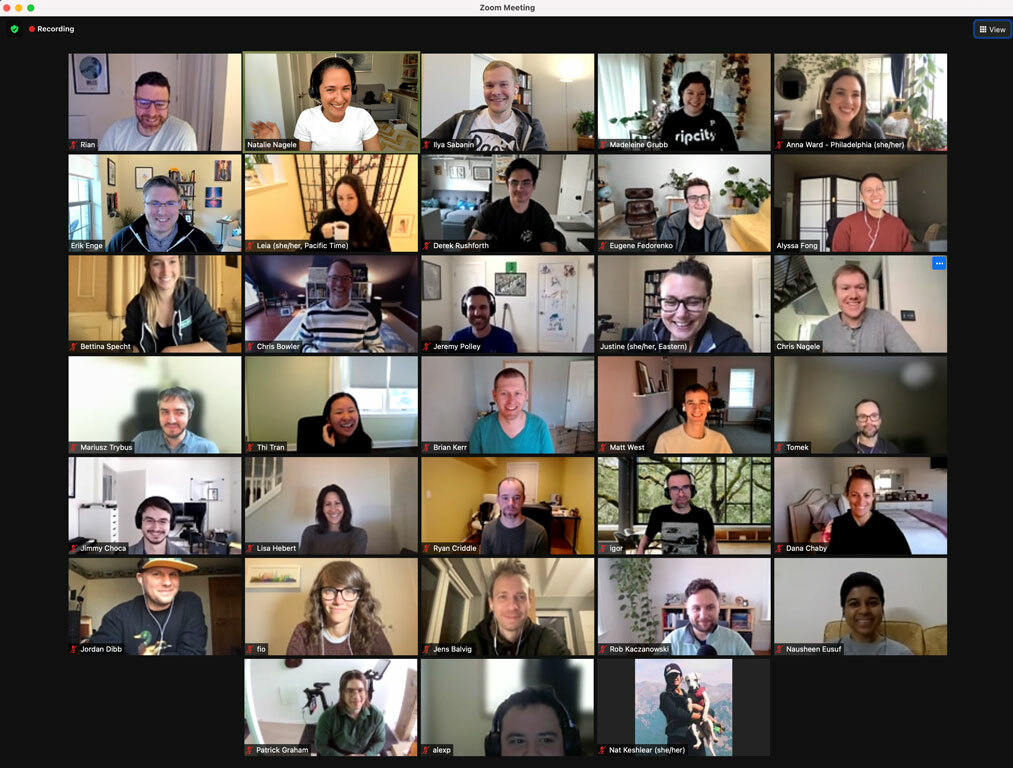
The Wildbit team during a monthly all-hands meeting
Continuing the conversation
Are you considering implementing a 4-day workweek at your company? If so, I encourage you to watch the full discussion here. In addition to the webinar recording, you’ll also find a list of useful links and resources.
If you’d like to follow Wildbit’s journey as a people-first company, you can do by signing up for our monthly newsletter. Or if you have questions or thoughts about the 4-day workweek, just send us a message.
We look forward to continuing the conversation.
PS: Special thanks to Nausheen Eusuf for her help researching and creating this article.

